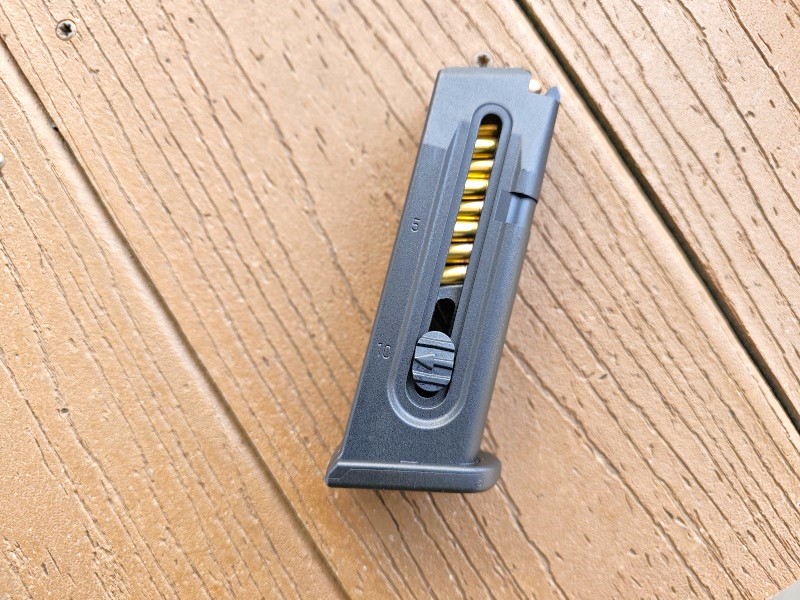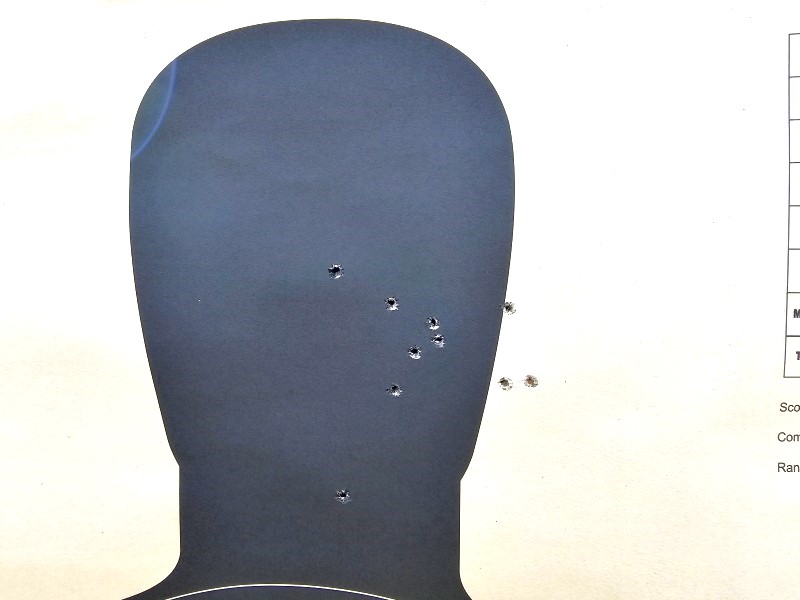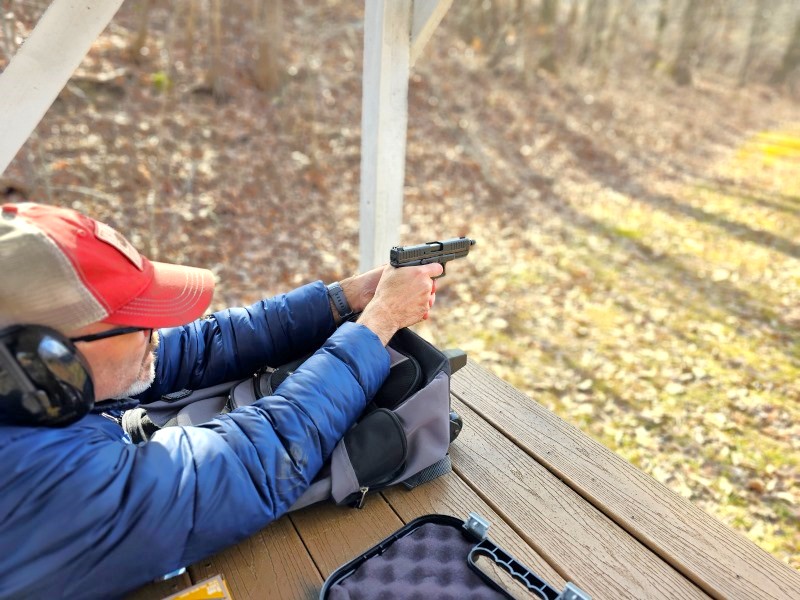In December 2019, Glock introduced their first .22 Long Rifle caliber pistol. Some folks were underwhelmed and opined that going to such a small caliber was a step backward. They’d been looking forward to a larger caliber in the new pistol.
From what I understand about Glock’s reasoning behind introducing a .22 LR pistol, their intentions were largely to provide a viable training pistol that allows people to inexpensively spend time on the range. Aside from training, it would also permit people to have cheap plinking time. And while these are certainly two attributes of the Glock 44, there are definitely others that we’ll get into in due time.
First, though, why don’t we take a closer look at the Glock 44 and see what the technical specifications are?
Tech Specs
The first thing noticeable about the pistol we tested was the barrel. Rather than the standard barrel, this one has an extended, threaded barrel, which makes attaching a sound suppressor a simple task. Unfortunately, we did not have a suppressor. The barrel length is around 4.5 inches, and the data states that the threading is .75 RH with a 1/2×28 adapter.
The standard (non-threaded) barrel is 4.02 inches, the same as the Glock 19. As a point of fact, the dimensions of the Glock 44 are the same as the Glock 19. At a glance, it’s difficult to tell the G44 apart from the G19, save for the smaller bore.
When you get them in hand, you can tell because the Glock 44 is slightly lighter at 12.63 ounces. Part of that is the fact that the slide is largely polymer and has metal parts molded into it.
The overall length is 7.28 inches. With the magazine inserted, the height is 5.04 inches. The slide is one inch thick, and the frame is 1.26 inches at its thickest—the same overall size as the Glock 19. The slide also features forward and rear serrations.
There is also a loaded chamber indicator in the form of a hole at the rear of the barrel hood on top of the ejection port so operators can see if there is a round in the chamber.
Magazines
The Glock 44 magazines are genuine Glock magazines with a 10-round capacity. They have tabs on both sides of the magazine that can be pulled down, making the loading of the magazine very easy. The magazine is mostly constructed of polymer and has a steel spring.

Grip
The magazine well is flared, which helps to load magazines into the pistol more easily and quickly. The grip features Glock’s Rough Texture frame, allowing a good purchase. On top of that, there are multiple beavertail backstraps, which makes the grip modular. Customizing the grip size is a useful option, given that this pistol is designed to be used by a wide array of shooters.

Happily, Glock went with a straight front strap on their grip rather than including finger grooves. Overall, the grip is very comfortable and impossible to tell apart from a Glock 19 grip.
Trigger
The Glock 44 uses the same Safe Action System as all of its other pistols. In fact, the entire frame looks exactly like every other Glock in the lineup. This is interesting, as some manufacturers significantly change the internals of their .22 caliber service pistols. Glock did not do that here.
The trigger pull was…well, it was 100% Glock. There’s a long take-up, then you hit the wall, and it breaks. The break is not light, but it’s not terribly heavy.
Controls
There is an ambidextrous slide stop on the Glock 44. The magazine release is a standard Glock and works exactly as expected, and it is reversible, should the user decide to swap it to the other side of the grip.
The takedown tabs on either side of the pistol are the same as on their other models.
Sights
Unfortunately, the sights on the Glock 44 are polymer, like most of their other sights. Perhaps sometime, Glock will realize that their customers like metal sights instead of polymer from a durability aspect.

The front sight has a red fiber optic insert that is very visible and quick to pick up. The rear sight is adjustable (though we didn’t need to adjust it in our shooting session). The rear sight also has the famous Glock “Goal Post” outline, which is excellent.
Rail
There is a Picatinny rail on the front of the frame with one notch, so lights, lasers, and other “tacticool” goodies can be added to the Glock 44.
Accuracy
We were pleasantly surprised in this department. From 15 yards, we shot a group that was about four inches across (excluding a flyer). Considering we were shooting offhand and rapidly, this was stellar performance, and much better than we expected going in.

We moved the target all the way out to 50 yards and were still able to shoot respectable groups, though they obviously opened up at that distance.
Reliability
Here again, we were pleasantly surprised. Reliability with several brands of .22 ammo was 100% perfect. Aguila, Federal, and CCI ammunition all performed flawlessly. Even the hollow point ammo from Aquilla fed well.

Uses
The .22 Long Rifle is one of the most versatile calibers in existence. It’s inexpensive, so shooters can stockpile a healthy amount of ammo.
Aside from that, it’s far lighter and more compact than most other rounds, so it can be stored in smaller spaces. Or if one were inclined, he or she could carry a lot of rounds into the field.
For training, a lot of shooting could be done on the cheap. A few hundred rounds don’t cost much and would last for hours. The fact that the Glock 44 looks and feels just like a Glock 19 (and other models) goes a long way toward training.
The .22 is a huge asset for survival or bugging out, as hundreds of rounds can be thrown into a pack, stored in a vehicle, or carried along in survival scenarios.
The .22 is fairly quiet. Again, this would be an asset during a survival scenario, as the noise would not travel very far, helping the shooter to keep a low profile.
While it’s not the most powerful round for self-defense, the .22 can still be quite lethal. Older folks with arthritis or other maladies might appreciate that the slide is not hard to rack, and there is very little recoil. The .22 is far quieter in a building when discharged than other calibers. For the elderly, a semi-auto .22 might be an option for self-defense when they might not be able to use heavier calibers.
All told, the .22 brings many assets to the table.
At The Range
All in all, our range session with the Glock 44 was extremely enjoyable. It felt pleasantly odd shooting a Glock with so little recoil, which becomes less enjoyable as we age. Given that we are accustomed to more recoil from Glocks, it took some getting used to with the Glock 44; you expect the pistol to jump when the trigger is pulled, and it just doesn’t happen with the .22 caliber Glock.

Another great byproduct of almost no recoil is the fact that follow-up shots can be incredibly fast. In fact, doing a mag dump into the target in a couple of seconds can be easily accomplished with a high degree of accuracy with the Glock 44.
As mentioned, the accuracy is very good for such a pistol. Reliability was perfect as well. These factors combined made the range session even more enjoyable.
Parting Shots
Some manufacturers drastically change the internals when they make a .22 caliber training version of a service pistol. For the most part, Glock did not do that here. Yes, they changed the slide; however, the frame is much the same as their other models.
It’s great for those who want a defensive pistol with low recoil and for those who want a low-cost trainer or bugout pistol.
With excellent reliability and accuracy, this pistol is sure to please. It’s a real pleasure to shoot and just plain fun at the range. It’s the perfect introductory pistol for a new shooter, so they won’t get spooked by recoil.
All in all, Glock has a real winner with the Glock 44.


